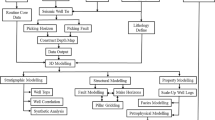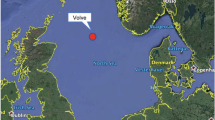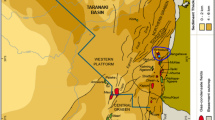Abstract
The multi-disciplinary work described in the paper was aimed at analyzing and predicting the cyclical ground surface movements induced by underground gas storage (UGS) activities in a depleted gas field located in the Po Plain (Italy). The field has been operated as a storage facility for nearly three decades. Currently, the possibility of delta-pressuring the reservoir (i.e. to increase the maximum operating pressure above the initial reservoir pressure) to enhance the storage performance is being considered. Significant information was collected over time: 2/3D seismic surveys, geological and sedimentological studies, 60+ logged wells, geotechnical lab tests and 50+ years of production history and monitoring were available for the development of a fully integrated static–dynamic–geomechanical analysis. The mechanical aspects of the study are the focus of this paper. The data coming from different sources at different scales were analysed and integrated to set up and characterize a 3D finite element method mechanical model to calculate the surface movements induced by UGS activity by adopting an elasto-plastic constitutive law. The model was then calibrated via a back analysis approach, i.e. the model parameters were fine-tuned so that the simulated subsidence/uplift would compare satisfactorily with the ground movements collected over nearly 10 years of monitoring via interferometric synthetic aperture radar analysis in the region under investigation. Eventually, the calibrated model was used as a forecasting tool for subsidence evaluation under different future storage strategies, including delta-pressuring conditions. Results proved that no significant subsidence is expected even if the maximum operating pressure reached 120 % of the initial formation pressure.




















Similar content being viewed by others
References
Agip S.p.A. (1982) Lessico delle Formazioni del bacino padano orientale. In: Cremonini G, Ricci Lucchi F (eds) Guida alla Geologia del margine appenninico-padano. Guide geologiche regionali. Società Geologica Italiana, Rome, pp 205–247
Baù D, Ferronato M, Gambolati G, Teatini P (2002) Basin-scale compressibility of the Northern Adriatic by the radioactive marker technique. Géotechnique 52(8):605–616. doi:10.1680/geot.2002.52.8.605
Berardino P, Costantini M, Franceschetti G, Iodice A, Pietranera L, Rizzo V (2003) Use of differential SAR interferometry in monitoring and modelling large slope instability at Maratea (Basilicata, Italy). Eng Geol 68:31–51. doi:10.1016/S0013-7952(02)00197-7
Boccaletti M, Calamita F, Deiana G, Gelati R, Massari F, Moratti G, Ricci Lucchi F (1990) Migrating foredeep-thrust belt system in the Northern Apennines and Southern Alps. Palaeogeogr Palaeocl 77:3–14. doi:10.1016/0031-0182(90)90095-O
Boccaletti M, Corti G, Martelli L (2011) Recent and active tectonics of the external zone of the Northern Apennines (Italy). Int J Earth Sci 100:1331–1348. doi:10.1007/s00531-010-0545-y
Ciccotti M, Almagro R, Mulargia F (2004) Static and dynamic moduli of the seismogenic layer in Italy. Rock Mech Rock Eng 37(3):229–238. doi:10.1007/s00603-003-0019-7
Dean RH, Gai X, Stone CM, Minkoff SE (2003) A comparison of techniques for coupling porous flow and geomechanics. SPE 79709-MS. In: Proceedings of the SPE reservoir simulation symposium, 3–5 February, Houston, Texas, USA. doi: 10.2118/79709-MS
Dean RH, Gai X, Stone CM, Minkoff SE (2006) A comparison of techniques for coupling porous flow and geomechanics. SPE J 11(01):132–140. doi:10.2118/79709-PA
Eurocodes. EN (1996) Eurocode 6: design of masonry structures. http://eurocodes.jrc.ec.europa.eu/
Eurocodes. EN (1997) Eurocode 7: geotechnical design. http://eurocodes.jrc.ec.europa.eu/
Ferretti A, Prati C, Rocca F (2001) Permanent scatterers in SAR interferometry. IEEE Trans Geosci Remote Sens 39(1):8–20. doi:10.1109/36.898661
Ferronato M, Gambolati G, Teatini P (2003) Unloading-reloading uniaxial compressibility of deep reservoirs by marker measurements. In: Proceedings of the 11th international FIG symposium on deformation measurements, Santorini Island, Greece
Foti S, Lancellotta R (2004) Soil porosity from seismic velocities. Geothecnique 54(8):551–554. doi:10.1680/geot.2004.54.8.551
Ghielmi M, Minervini M, Nini C, Rogledi S, Rossi M, Vignolo A (2010) Sedimentary and tectonic evolution in the eastern Po-Plain and northern Adriatic Sea area from Messinian to Middle Pleistocene (Italy). Rend Fis Acc Lincei 21(Suppl 1):S131–S166. doi:10.1007/s12210-010-0101-5
Ghielmi M, Minervini M, Nini C, Rogledi S, Rossi M (2013) Late Miocene–Middle Pleistocene sequences in the Po Plain–Northern Adriatic Sea (Italy): the stratigraphic record of modification phases affecting a complex foreland basin. Mar Pet Geol 42:50–81. doi:10.1016/j.marpetgeo.2012.11.007
Mancin N, Di Giulio A, Cobianchi M (2009) Tectonic vs. climate forcing in the Cenozoic sedimentary evolution of a foreland basin (Eastern Southalpine system, Italy). Basin Res 21:799–823. doi:10.1111/j.1365-2117.2009.00402.x
Castelletto N, Ferronato M, Gambolati G, Janna C. Teatini P, Marzorati D, Cairo E, Colombo D, Ferretti A, Bagliani A, Mantica, S (2010) 3D geomechanics in UGS projects. A comprehensive study in northern Italy. ARMA 10-185. In: Proceedings of the 44th US rock mechanics symposium and 5th U.S.-Canada rock mechanics symposium, 27–30 June, Salt Lake City, UT
Mashinsky EI (2003) Differences between static and dynamic elastic moduli of rocks: physical causes. Russ Geol Geophys 44(9):953–959
Massoli D, Koyi HA, Barchi MR (2006) Structural evolution of a fold and thrust belt generated by multiple décollements: analogue models and natural examples from the Northern Apennines (Italy). J Struct Geol 28:185–199. doi:10.1016/j.jsg.2005.11.002
Mathias SA, Hardisty PE, Trudell MR, Zimmerman RW (2010) Screening and selection of sites for CO2 sequestration based on pressure buildup. Int J Greenh Gas Control 4:108–109
National Office for Hydrocarbons and Mining georesources of Italy (UNMIG) website. http://unmig.sviluppoeconomico.gov.it. Accessed 4 Nov 2015
Ori GG, Friend PF (1984) Sedimentary basins formed and carried piggyback on active thrust sheets. Geology 12(8):475–478. doi:10.1130/0091-7613(1984)12<475:SBFACP>2.0.CO;2
Pieri M (1983) Three seismic profiles through the Po Plain. In: Bally AW (ed) Seismic expression of structural styles. American Association of Petroleum Geologists (AAPG), Tulsa, pp 8–26
Pieri M, Groppi G (1981) Subsurface geological structure of the Po Plain, Italy. C N R Prog Fin Geodin 414:1–13
Ricci Lucchi F (1986) The Oligocene to recent foreland basins of the northern Apennines. In: Allen PA, Homewood P (eds) Foreland basins. Blackwell Publishing Ltd, Oxford, pp 105–139. doi:10.1002/9781444303810.ch6
Rohmer J, Bouc O (2010) A response surface methodology toaddress uncertainties in cap rock failure assessment for CO2 geological storage in deep aquifers. Int J Greenh Gas Control 4(2):198–208. doi:10.1016/j.ijggc.2009.12.001
Rutqvist J, Wu Y-S, Tsang C-F, Bodvarsson GA (2002) A modeling approach for analysis of coupled multiphase fluid flow, heat transfer, and deformation in fractured porous rock. Int J Rock Mech Min Sci 39(4):429–442. doi:10.1016/S1365-1609(02)00022-9
Selvadurai APS (2009) Heave of a surficial rock layer due to pressures generated by injected fluids. Geophys Res Lett 36:Ll4302. doi:10.1029/2009GL038187
Settari A, Maurits FM (1998) A coupled reservoir and geomecanichal simulation system. SPE J 3(03):219–226. doi:10.2118/50939-PA
Settari A, Sen V (2007) The role of geomechanics in integrated reservoir modeling. Leading Edge 26(05):622–627. doi:10.1190/1.2737102
Settari A, Walters DA (2001) Advances in couplet geomechanical and reservoir modeling with applications to reservoir compaction. SPE J 6(03):334–342. doi:10.2118/74142-PA
Soltanzadeh H, Hawkes CD (2009) Assessing fault reactivation tendency within and surrounding porous reservoirs during fluid production injection. Int J Rock Mech Min Sci 46(1):1–7. doi:10.1016/j.ijrmms.2008.03.008
Streit JE, Hillis RR (2004) Estimating fault stability and sustainable fluid pressures for underground storage of CO2 in porous rock. Energy 29(9–10):1445–1456. doi:10.1016/j.energy.2004.03.078
Teatini P, Castelletto N, Ferronato M, Gambolati G, Janna C, Cairo E, Marzorati D, Colombo D, Ferretti A, Bagliani A, Bottazzi F (2011) Geomechanical response to seasonal gas storage in depleted reservoirs: a case study in the Po River basin, Italy. J Geophys Res. doi:10.1029/2010JF001793
Toscani G, Burrato D, Di Bucci D, Seno S, Valensise G (2009) Plio-Quaternary tectonic evolution of the Northern Apennines thrust fronts (Bologna-Ferrara section, Italy): seismotectonic implications. Ital J Geosci 128(2):605–613. doi:10.3301/IJG.2009.128.2.605
Acknowledgments
The authors wish to thank Stogit for permission to publish the data presented in this paper.
Author information
Authors and Affiliations
Corresponding author
Rights and permissions
About this article
Cite this article
Codegone, G., Rocca, V., Verga, F. et al. Subsidence Modeling Validation Through Back Analysis for an Italian Gas Storage Field. Geotech Geol Eng 34, 1749–1763 (2016). https://doi.org/10.1007/s10706-016-9986-9
Received:
Accepted:
Published:
Issue Date:
DOI: https://doi.org/10.1007/s10706-016-9986-9




